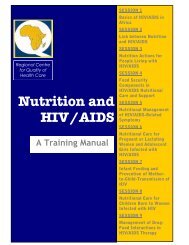2.1: Anthropometric Indicators Measurement Guide - Linkages Project
2.1: Anthropometric Indicators Measurement Guide - Linkages Project
2.1: Anthropometric Indicators Measurement Guide - Linkages Project
Create successful ePaper yourself
Turn your PDF publications into a flip-book with our unique Google optimized e-Paper software.
7.1. Sources of Epi Info Software<br />
Public domain sources of Epi Info<br />
software and supporting materials<br />
Epi Info is available from the Centers<br />
for Disease Control and Prevention (CDC),<br />
1600 Clifton Road,<br />
Atlanta, GA 30333, USA<br />
or downloaded from:<br />
www.cdc.gov/epiinfo/<br />
The Epi Info 2000 package comes with<br />
a manual and tutorials to help the user to<br />
become familiar with data analysis using<br />
Epi Info.<br />
7.2. Recommendation for Analysis and Presentation of Height Data<br />
For evaluation purposes, the presentation of<br />
stunting data for children less than 24<br />
months is useful. An intervention among<br />
children under 24 months is likely to be<br />
more effective than among children 24-59<br />
months. This is because 1) the determinants<br />
of stunting in the older children<br />
are more varied, and 2) stunting in older<br />
children may reflect historical nutritional or<br />
health stress and be ‘permanent,’ i.e. not<br />
responsive to any intervention. A further<br />
consideration in the presentation of data on<br />
stunting by age groups is the change in<br />
measurement technique at 24 months of<br />
age. Data on length for children less than<br />
24 months should not be grouped together<br />
with data on height for children more<br />
than 24 months of age.<br />
Prevalence - For use in Title II programs,<br />
the prevalence of nutritional status<br />
conditions can be calculated using cut-off<br />
points for height-for-age and weight-forage.<br />
The cut-off points can be set using Z-<br />
scores, percentiles or percentage of the<br />
median. For Title II programs, a cut-off of<br />
-2 Z-score is recommended and results<br />
should be presented for both males and<br />
females. An example of a prevalence table<br />
for low height-for-age as established by -2<br />
SD for groups of children aged 6 - 59.99<br />
months is given below:<br />
Table 7.1. Prevalence of low height-for-age (stunting) in a sample of 97 children,<br />
by sex and age group<br />
7.<br />
Age Group<br />
(months)<br />
< 6<br />
6-11.99<br />
12-23.99<br />
24-35.99<br />
36-47.99<br />
48-59.99<br />
Total<br />
Sex<br />
Boys<br />
Girls<br />
Combined<br />
Boys<br />
Girls<br />
Combined<br />
Boys<br />
Girls<br />
Combined<br />
Boys<br />
Girls<br />
Combined<br />
Boys<br />
Girls<br />
Combined<br />
Boys<br />
Girls<br />
Combined<br />
Boys<br />
Girls<br />
Combined<br />
Number below<br />
cut-off (-2 SD)<br />
0<br />
0<br />
0<br />
0<br />
0<br />
0<br />
1<br />
2<br />
3<br />
0<br />
4<br />
4<br />
6<br />
3<br />
9<br />
6<br />
5<br />
11<br />
13<br />
14<br />
27<br />
Number in age<br />
group<br />
6<br />
4<br />
10<br />
6<br />
3<br />
9<br />
6<br />
10<br />
16<br />
7<br />
13<br />
20<br />
10<br />
10<br />
20<br />
15<br />
7<br />
22<br />
50<br />
47<br />
97<br />
Percentage below<br />
cut-off<br />
0.0<br />
0.0<br />
0.0<br />
0.0<br />
0.0<br />
0.0<br />
16.7<br />
20.0<br />
18.8<br />
0.0<br />
30.8<br />
20.0<br />
60.0<br />
30.0<br />
45.0<br />
40.0<br />
71.4<br />
50.0<br />
26.0<br />
29.8<br />
27.8<br />
Overall, this table shows that 26.0 percent of the boys had a low height-for-age or were stunted, while 29.8 percent<br />
of girls were stunted. Interpretations can also be made about the various age groups or with boys and girls<br />
grouped together.<br />
44

















